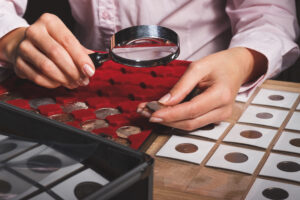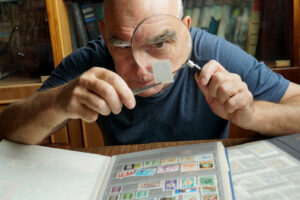
Hot property: Do you own some hidden treasure? Part 1
Last updated on October 10th, 2023
If you’re a serious collector, chances are you’re not prepared to part with anything in your possession without good reason.
But what if you found out something that’s been gathering dust on top of a shelf or hidden in boxes under the stairs was highly collectible and therefore valuable? Perhaps it’s the coin or stamp collection you started when you were a kid and abandoned when you discovered the Xbox?
Or maybe you’ve been wondering if that collection of retro Barbies you’ve held on to for sentimental reasons is now valuable because of the buzz around Margot Robbie’s new Barbie film. After all, limited edition Elsa dolls from Frozen can fetch upwards of $7500 on EBay.

You could be sitting on a windfall if you just know what to look for. And while you might not have a vintage car or case of expensive wine to sell, your collectible items could still fetch you a few hundred or thousand of dollars.
So what is collectible and how do you find out what your items are worth? And, on the flipside, if you do want to get into the collecting game, how do you know what you are buying is genuine?
What makes an item collectible?
Collectibles are items that collectors treasure for various reasons. Here's what can make an item a sought-after collectible:
Value
This is not just about money, though that can be a factor. A collectible's worth can come from emotional ties, history, or cultural importance. For example, a carved shield by Wurundjeri artist William Barak auctioned for more than $74,000. The shield's intricate geometric design and unique motif reflect not only its monetary value but also its deep cultural and historical ties with the Wurundjeri community.
Rarity
The harder something is to find, the more people might want it. Remember the 2000 Australian mule $1 coin? A mix-up at the Mint resulted in only six thousand of these unique coins making it into circulation before the mistake was discovered. It was produced when a technician at the Royal Australian Mint accidentally paired the obverse (heads side) die intended for the 10-cent piece with the reverse (tail side) die of the $1 coin. This resulted in a coin with a double rim on the Queen's side and a slightly "squished" image. Today, one could fetch over $4000.
Age
While not all old items are collectible, age can add to an item's allure. Antiques, at least 100 years old, often have a unique charm and history that newer items might lack. Take Jan Febey's mantle clock, bought by her late mother in the 1970s, possibly from a Tasmanian dairy farm sale. This clock, believed to be of French origin, is valued between $400 and $550.
Most popular collectibles in Australia
Australia is home to a vibrant community of collectors. The top picks from the nation’s favourite antiques and collectibles websites reveal the following treasures:
-
- Precious metals and coins - Websites like perthmint.com and ramint.gov.au show Aussies love their shiny keepsakes. These renowned mints offer a variety of collector coins, bullion, and other precious metal items.
- LEGO collections - brickset.com caters to LEGO enthusiasts. From limited edition sets to quirky themes, LEGO's appeal as both toy and collectible remains unbeatable.
- Coins, notes, and stamps - The popularity of downies.com tells us that coins, banknotes, and stamps haven't lost their sparkle. Special editions from these categories are among the most cherished keepsakes.
- Antiques and valuables - A peek at worthpoint.com reveals that Aussies have a wide range of interests, from vintage toys to historic relics. It's a treasure trove of sales records, visuals, and item descriptions.
Perhaps one of the most lavish collectibles in Australian history is a diamond-studded 99 percent gold coin, which was valued at $2.5 million in 2018.
While trends change, some collectibles stand the test of time. Coins and stamps, with their intricate designs and storied pasts, have been adored for ages. Their rich history, the stories they tell, and the craftsmanship involved in their creation make them perennial favourites among collectors.
What are collectors looking for?
Collectors, diverse in their interests, scout for items that resonate with their passions. But when it comes to the allure of a collectible, several key attributes stand out:
Rarity

The scarcer an item is, the more valuable it becomes. Limited editions, short-lived products, or items that have been discontinued often become hot commodities in the collectibles market.
Condition
An item in pristine shape, especially if it's boxed as new, is a collector's dream and will usually fetch a higher price than something worn out or damaged. Keep collectibles in tip-top condition with regular maintenance and proper storage to preserve their value.
Historical significance
If an item has brushed against history or tells a unique tale it will likely be in demand. Collectors cherish things like signed memorabilia or items linked to notable personalities.
Authenticity
In a world where fakes abound, genuine proof of an item's origin is a game-changer. Whether it's a certificate, a traceable history, or an expert's nod, authenticity ups an item's value.
Aesthetic appeal
Some collectibles win hearts simply by being stunning. Art pieces, designer items, or even toys with intricate details can attract collectors.
Nostalgia
Nostalgia is a powerful magnet. Items that teleport collectors back to the past, especially from childhood, can be highly sought after. Think vintage video games, old toys, or first-edition books.
Investment potential
For many, collecting isn't just a hobby but a smart investment. They're on the lookout for treasures that promise to grow in value, such as rare coins, stamps, or artworks.
How do you find out what collectibles are worth?
Determining the value of a collectible can be both an art and a science. While some collectibles have a well-known market price, others might need more in-depth investigation into their origin, scarcity, and popularity. Here's how you can confidently estimate your collectible's value:
Research online
Start with a simple online search of your item. Platforms like eBay or Gumtree showcase what items are fetching in real-time. It's crucial to focus on 'sold' listings to gauge the actual transaction prices, not just what sellers hope to get.
Consult price guides
Specific guides, like the Beckett Price Guide for coins, stamps, or vintage toys, offer price ranges based on the latest market data. These guides are routinely updated and can provide a reliable estimate of an item's value.
Visit specialist dealers
For those rare gems, it's wise to consult dealers with expertise in that specific domain. Their deep knowledge can shed light on your item's background, scarcity, and demand. Always reach out to multiple experts for a holistic view.
Attend appraisal events
Every so often, entities like museums or collectors' clubs hold events where aficionados assess items. It's an excellent opportunity to get feedback from seasoned professionals.
Review auction outcomes
Well-known auction houses like Sotheby's, Christie's, and Bonhams often publish results from their auctions. By studying these, you can discern what ardent collectors are genuinely spending on similar items.
Consider professional grading
The condition can drastically alter an item's value. If you believe your item is in impeccable shape, perhaps even in its original packaging, get it graded professionally. It's a trusted way to determine its condition and can help you to avoid scams.
Authenticate your treasures
If you own a high-value collectible, validate its authenticity. This step doesn't just safeguard against counterfeits but can also amplify its market appeal. Various services specialise in authenticating different kinds of collectibles.
Factor in market trends
The world of collectibles is ever-evolving. An item in vogue today might lose its allure tomorrow. Engage with collector communities, peruse industry magazines, and partake in conventions to keep a finger on the pulse of market dynamics.
Treasure or trinket?

We hope this has inspired you to take a good look at your forgotten possessions and see if they are worth something. Even if you decide not to cash in on any hidden treasures but hold on to them for the next generation, it’s good to know their worth. And if you have bought something that you thought was a treasure but turned out to be a trinket, lodge a complaint with us, and we’ll help you handle it.
Check out the Part 2 of our collectibles journey, where we dive deeper into the practicalities of collecting, ensuring you're well-equipped to make informed decisions.






